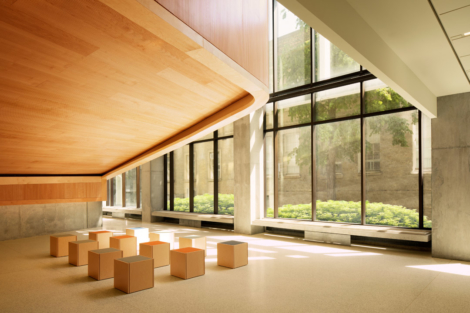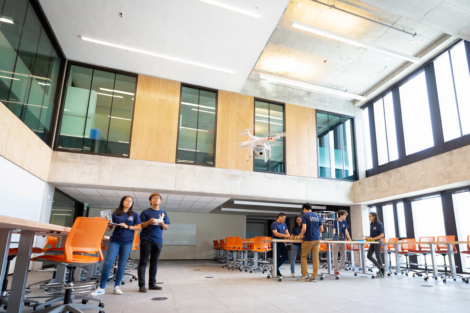The Myhal Centre for Engineering Innovation & Entrepreneurship exemplifies an architecture that is quiet and understated, so that the focus remains on the activities that will occur within it and not on the building itself.
This was the premise for the Myhal Centre, named after U of T alumni George and Rayla Myhal, which officially launched in May since plans for its construction were first drawn out ten years ago.
Chief architects Robert Davies and Peter Clegg drew inspiration from Canadian-born painter Agnes Martin for the design of the Myhal Centre. Martin’s work drew inspiration from Western and Chinese Classicism, sharing the belief that perfection can only exist in the mind. At first glance, Martin’s paintings aspire to engineering precision, but a closer look reveals freely drawn lines and purposeful imperfections.
In a similar sense, Davies and Chegg designed the Myhal Centre to an idea of engineering precision while encouraging the messy and chaotic activities of human beings.
Most of the spaces in the Myhal Centre are managed by the Faculty of Applied Science & Engineering, while others, like the classrooms and Technology Enhanced Active Learning (TEAL) rooms, are managed by Academic & Campus Events. As such, many courses that will be taught in the new building this fall not only include engineering, math, and computer science, but also archaeology, kinesiology, and earth science.
Aside from its architectural ingenuity, the Myhal Centre is also one of U of T’s most ‘green’ buildings — it has features like cisterns to collect and recycle rainwater, solar panels, and a green roof.
The Skule Arena on Level 0 was supported by a $1 million donation from the Engineering Society, the undergraduate student government of the Faculty of Applied Science & Engineering. The Skule Arena is an interactive space that will support over 100 clubs and teams U of T Engineering students are a part of. Members of the Human Powered Vehicles Design Team are seen here using the Skule Arena to work on their speedbike.
This level also features a soundproof room, which musical groups and students can use to rehearse, and the Engineering Society Arena, which has garage-style spaces to support clubs and other student activities. Lockers are on this level and other floors for students to store instruments, materials, or projects.
The Skule Arena will support undergraduate teams like the University of Toronto Aerospace Team (UTAT).
From left: Jaden Reimer, Timothy Yeung, Ali Haydaroglu, Mohamed Hirole, Madeline Zhang, Justin Hai, Sandy Fogarassy, David Izatt, and Michael Ding.
A central theme of this facility is that every space is functional and light pours in from every angle. The foyer on the Level 1 of the Myhal Centre is a prime example of this. This is a space where students can study or meet with other students between classes.
The Lee & Margaret Lau Auditorium is a 468-seat technology enhanced auditorium and is the first of its kind in North America. It doesn’t have your typical blackboard, and instead features a wall-to-wall digital array. Instead of rows, this lecture hall has tables to seat six students.The auditorium can be entered from Level 1 or Level 2. As well, a Second Cup is currently being constructed on Level 2.
Here, U of T Engineering Professor Chirag Variwa is seen teaching a class in a TEAL room. Five TEAL rooms are located on Levels 3 and 4 which have screens on every wall and movable tables instead of desks. This flexibility is designed to encourage collaboration that isn’t bound by the classroom’s set configuration.
Level 5 houses various design and fabrication facilities, many of which are open outside of regular classroom hours. Such facilities include the Light Fabrication Facility where students can build parts out of plastic, metal, or wood, and a Prototype Facility that comes with a laser cutter and 3D printers.
From left: students Stephen Dawes, Stephanie McDonald, and Nicholas Chin are seen here creating a prototype in the Myhal Centre for their startup, Hotbox.
The Norris Walker 5T7 Robotics Lab on Level 5 is an atrium space and will be the new home of the Institute for Robotics & Mechatronics, a cross-disciplinary lab centred on robotics research with applications to real-world problems. Applications of such research include socially assistive robots like those developed from the laboratory of Professor Goldie Nejat, and targeted drug delivery systems like those developed from Professor Eric Diller’s research laboratory.
The atrium on Level 5 is similar to the foyer in that it’s an open space with tables and desks so that students can work between class time.
From left: Chloe Oriotis, Dean of the Faculty of Applied Science & Engineering Cristina Amon, and Sabrina Cupryk.
Launched in 2012, the Entrepreneurship Hatchery is one of the largest and most successful startup accelerators at U of T. The Hatchery helps provide startups access to networking opportunities, space, funding, and equipment. Its new space at the Myhal Centre features large, open spaces to facilitate collaboration. Notable startups include Tejo, Knowtworthy, and Column Mods.
Level 7 is home to the Centre for Global Engineering (CGEN) which enables engineers to solve some of the world’s most pressing issues involving nutrition, sanitation, health, and shelter. One of the centre’s ongoing projects is fortifying foods like tea and salt with iron to prevent and treat anemia. To implement innovative solutions like fortified foods, CGEN partners with organizations and academic institutions around the globe.
The CN Tower and the Art Gallery of Ontario can both be seen from the south view of the Dr. Woo Hon Fai Terrace on the eighth floor. The Terrace is a space for students and faculty from across engineering disciplines to meet and take in the panoramic views of Front Campus and the Toronto skyline. This level is also home to the Institute for Sustainable Energy and the Institute for Water Innovation.
Editor’s Note (September 17): This article has been updated to include a more accurate description of Level 5.













